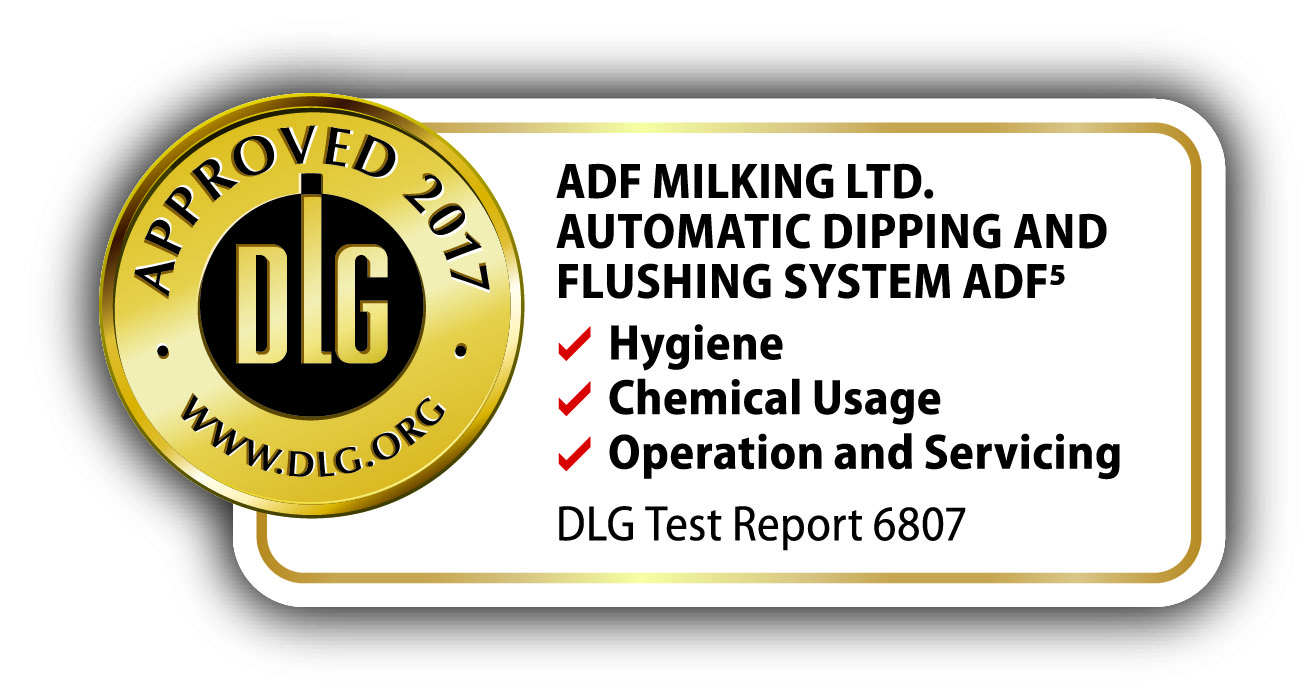ADF Milking Deutschland GmbH Automatic Dipping and Flushing System ADF5
DLG-Approved "Hygiene, Chemical Usage, Operation and Servicing"
The certification mark
A certification mark ‘Recognised by the DLG in individual criteria’ is given to agricultural technology products that have successfully passed a reduced-scope examination of practical value, according to independent and recognised test criteria. The tests serve to highlight specific innovations and key criteria of the product tested. The test can encompass criteria taken from the DLG framework for complete testing or focus instead on other value-deciding characteristics and features of the product. The minimum requirements, test conditions and procedures, as well as the basis of assessment are set out in agreement with a group of DLG experts. They correspond to the recognised rules governing the technology, as well as to scientific and agricultural findings and requirements. The successful test concludes with the publication of a test report as well as the awarding of a certification mark, valid for 5 years from the date on which it is awarded.
In the following DLG recognised examination, for the awarding of a DLG certification in single criteria, different hygiene aspects of the ADF5 automatic dipping and flushing system, in the laboratory and in practice, were examined. Principal focus was put on the disinfection of teat and cluster as well as on the chemicals therefore required. The subject of iodine residue was also discussed. The usage of iodine and peracetic acid solution were determined by measurement in practice. A survey of system users has supported the evaluation of the operation and servicing of the ADF5 system. The tests were carried out in accordance with the DLG testing parameters for automatic milking systems, as of April 2013, as well as according to the decisions of the DLG Testing Commission for Milking Technology, applying supplementary criteria. Other criteria beside those here named were not applied.
Assessment – Brief Summary
The ADF5 system was able to completely demonstrate its strengths through both of its central functions. The teats were reliably and completely coated with dip, the formation of drops of dip at the teat canal being evident. Laboratory tests pointed toward a physiological cause for the slight increase in iodine in the milk in the bulk tank that was seen in practice. No technical cause for this could be statistically proven. The flushing of the clusters with peracetic acid in between milkings proved its efficiency in practice.
The handling of the system and the servicing provided by the manufacturer were regarded throughout by the system users as positive, with only the liner change seen as relatively more complex.
Table1: Results in summary
| Examination | Criteria | Examination Result Assessment* |
|---|---|---|
| Animal Related Criteria | ||
| Teat disinfection and care | ||
| Functionality of the dip equipment | very good, reliable | + + |
| Equality of the apportioning of dip | observed: 100 % coverage of the teats | + + |
| Build up of drops (of dip) around the teat canal | always observed | + + |
| TECHNICAL CRITERIA | ||
| Hygiene | ||
| Efficiency of the flushing/disinfection of the cluster. | ‘none’ to ‘few’ aerobic bacteria in the head of the cluster and cluster assembly detectable | + |
| Chemical usage | ||
| Chemical consumption | “iDip+” – iodophor-based dip (2500 ppm) | +¹ |
| “iFlush+” – peracetic acid solution, 5 % | + ² | |
| Ease with which peracetic concentration can be monitored | easy with testing strips used in the flushing solution. This is routinely checked as part of the servicing (at least twice per year or every 6,000 milkings). Concentration should be 300 ppm. | + |
| Iodine residue in the milk | slight increase detectable cause not clearly identified, in laboratory tests increase statistically not proven | ◯ |
|
Peracetic acid residue – in the milk | no protein precipitation in the fat separator | + |
| – in the parlour air | light lingering odour detectable, dependent on the ventilation of the milking parlour | ◯ |
| Operation and Servicing | ||
| Overall operation | evaluated by users as ‘good’ | + |
| Functionality | highlighted by users as very positive | + + |
| Adjustment options only for the whole system | ◯ | |
| Cluster | good with regard to weight, milking claw, arrangement of tubing and vacuum cut-off | + |
| Servicing (overall) | evaluated by users as ‘good’ | + |
| Service from the manufacturer | obligatory service contract, including auto shipment delivery of chemicals and liners | + |
| Liner change | relatively more complex | ◯ |
* Evaluation range:: + + / + / ◯ / – / – – (◯ = standard)
1 ompared to Automatic Milking Systems (AMS)
2 compared to AMS
The product
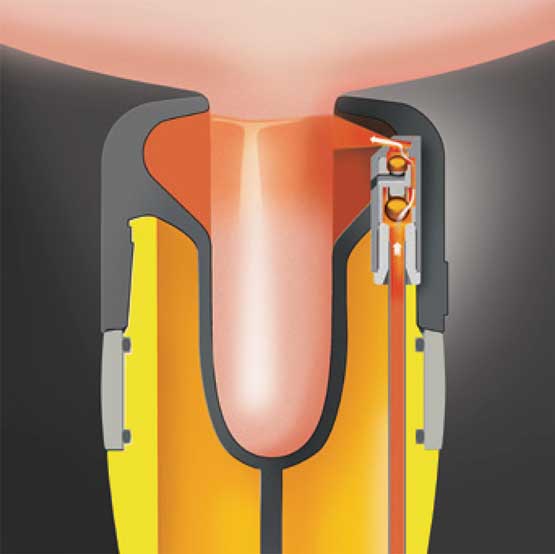
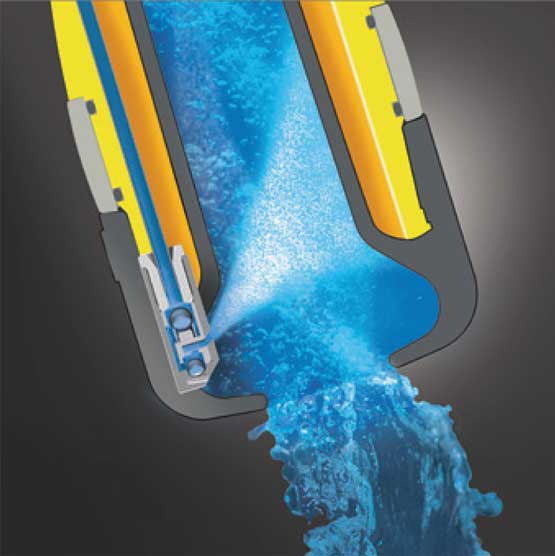
Automatic Dipping and Flushing System „ADF5“
Description and Technical Data
The ADF5 automatic dipping and flushing system of the company ADF Milking Ltd. was tested.
- Cluster with integrated injector in the head of the liner, with a gravity ball valve and check valves in the manifold and liners.
- Usable with alternating and synchronic pulsation
- Two additional lengths of tubing, one for the transport of dip and another for that of peracetic solution and compressed air.
- Plastic deflector above the whole unit to prevent the liners from crossing over each other after removal from the teat.
- Pump and control unit including Dosatron outside of the milking parlour.
- Dosage units at each milking point, connected to a chemical and compressed air supply ring.
- Remote system data retrieval via the service provided.
- Obligatory servicing contract with regular auto-supply of chemical and liners.
- Suitable for subsequent installation in parlours of all types, independent of the manufacturer.
Cluster weight: 1.95 kg, which can be increased to 300 g with supplementary weights (60 g each)
Claw volume: 300 ml
Figure 1: The ADF liner dipping (L) and flushing (R)
The method
Hygiene
Teat disinfection and care
The application of iodine based dip to the teats as well as the build up of the same at the opening of the teat canal was observed and recorded at 2 farms by the examiner. Furthermore, the degree of teat coverage was visually tested in the laboratory on artificial teats made of light coloured silicon.
Cluster cleaning and disinfection between milkings
In order to assess the efficiency of the cluster cleaning and disinfection process and, therefore, the risk of bacteriological transfer from cow to cow, test swabs were taken at 2 test farms from the liner’s head and shaft at every second milking point during the second half of a morning milking and bacteriologically tested.
The sampling, using damp swabs, occurred dependently of the recommended minimum time for the peracetic acid solution to take effect and, at the earliest, one minute fter the cluster disinfection.
Chemical usage
Chemical Consumption
On two farms, scales were installed to measure the difference in the weight of chemicals (dip and peracetic solution). Prior to the start of the test, the total number of milkings to date was recorded. Over a period of a week, the container weights were recorded and, at the end of the testing period the difference in weight offset against the number of milkings during that period.
Iodine Residue
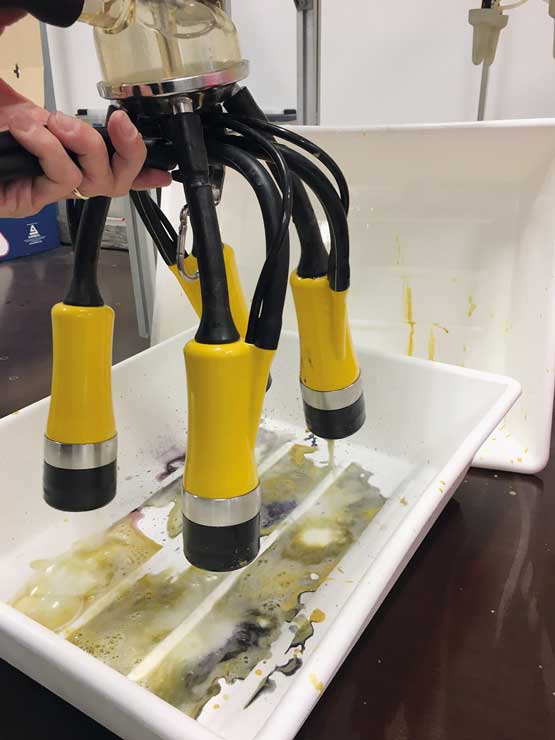
At test farm 1, samples were taken every second day from the bulk tank over a period of 20 days and tested for their iodine content. For the first ten days, the ADF5 system was used to automatically dip and during the following ten days, dipping was carried out by hand with a dip cup. The goal was to find out whether automatic dipping with the ADF system has an influence on the iodine content in the milk as compared with the standard dipping method.
To eliminate physiological influences, additional laboratory tests were carried out with an artificial cow. In the first test with the artificial cow, 10 ‘pre milking and dipping’ samples were taken from a
well homogenized mixture of UHT milk and water (1 : 1, about 48 l). There followed 12 milkings with a milked out volume of about 5l and thereafter automatic dipping and flushing. After this, the whole milk mixture was pumped round once more to ensure it remained well mixed and, from the mixture which then was in the tank, 10 samples were taken ‚post milking and dipping‘. All samples were then tested in a laboratory analysis for their iodine content.
The second test was carried out as the previous test, but with a 4 % starch solution (20l) instead of milk. At the end of each dipping and flushing cycle, the cluster was held over a white tub and drips of liquid residue and the cluster unit itself were monitored for an iodine reaction (i.e. a blue colouration). The goal was to identify any possible iodine residue in the liners and claw. Alongside ‘normal’ milkings, further tests were carried out with potentially problematic scenarios, such as, for example, a flipped over liner. The milked out starch solution was, in a similar way to the first test, examined for colouration before and after milkings.
Peracetic Acid residue
Peracetic acid is highly volatile and barely detectable in milk. In order to check whether residue of the disinfection solution from the ADF system remains in the milk, the fat separator was visually checked at two farms immediately after milking for protein precipitation.
Operation and Servicing
The Herd Managers and Milkers of both test farms were asked about their experiences with the ADF5 system. To back up these results, 25 users of the ADF system took part in an online survey, of which 21 completed the survey. The focus was on questions about the function and operability of the system, as well as about user satisfaction with it and the servicing provided.
The test farms
The practical tests took place on two larger Holstein farms in Sachsen-Anhalt. Their circa 600 (farm 1) and 350 milking cows (farm 2) respectively are taken twice daily from various sheds to milking. Milking occurs at both farms over a period of 3 to 4 hours and is carried out by milkers employed on farm.
Farm 1 has an internal rotary with 32 milking points, all fitted with the ADF5 system. The cows are taken to milking in groups according to their milking performance. Prior to the application of the cluster, the udders are manually cleaned with cleaned multi-use cloths, one per cow. The separate milking facility has a large room volume and is well ventilated.
Farm 2 has 2 5-a-side herringbone parlours in milking rooms with relatively low ceilings.
Ventilation occurs through the entrances and exits of the parlours. All 20 milking points are fitted with the
ADF5 system. The cows are taken to milking according to their shed or their milking performance, the cows with special needs going last. The cleaning of the udders is carried out with single-use towels, sometimes
with milk and salicylic acid based cleaning foam to remove larger amounts of dirt.
The average milk yield of the herd on farm 1 is 9,900kg, with the SCC stable at 220,000. On farm 2 the
average herd milk yield is 10,000kg and the SCC was at 210,000 when testing was carried out.
The test results in detail
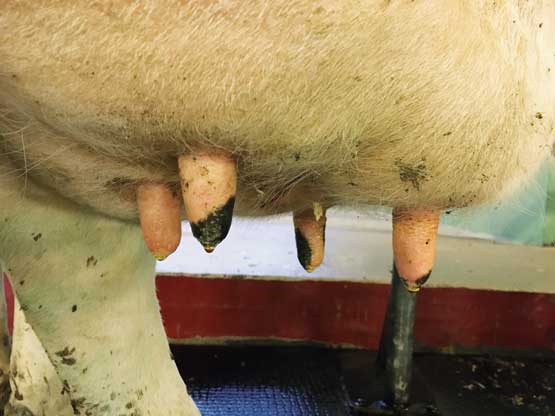
Teat disinfection after milking occurs via the application of dip in the liner, immediately before the removal of the cluster.
The point at which dipping occurs can be variably set from 0.0 to 1.0 seconds after vacuum is shut off. The amount of dip is regulated by the opening period of the valve (between 0.3 and 0.7 seconds).
As the liners pass over the teats, they are completely covered with dip. On both farms, a build up of dip was observed without fail at the end of each teat.
In the laboratory tests carried out by DLG on an artificial udder with idealised teats the shaft of the artificial teats were always completely covered with iodine solution after dipping. Sometimes, drops of it would be seen on the base of the udder, principally on the opposite side where the tubes are located into the cluster.
Ultimately this was not seen in practice and can possibly be attributed to the comparatively small size of the silicone teats.
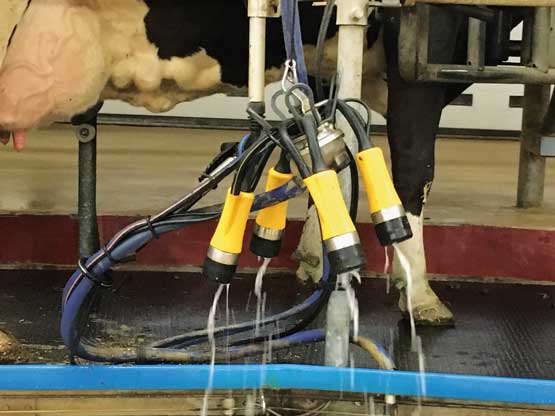
After milking, the cluster is automatically removed, where dipping occurs immediately before and during the removal. Unlike with other systems, the cluster can then hang with the claw in the same position as during milking, whereby the liners hang beneath with kinked short milk tubes (Figure 6).
A standard 5 seconds after dipping, flushing and disinfection of the liner occurs – the claw is not washed by the ADF system. The interval between dipping and flushing can be adjusted if needed.
For the flushing of the liner, the valve in the injector within the liner is opened 6 times in total – 4 times for 2 seconds and twice for 1 second: through this process, water and peracetic acid are sprayed into the liner. The roughly 400 ml to 450 ml of flushing solution contains peracetic acid in a concentration of around 300 ppm. On the test farms, test strips showed that the concentration was 400 pm, a little higher than it should be. After each flushing cycle, the liners are blown dry with compressed air. Rinsing with water thereafter does not occur.
On the test farms, some crossed over liners were observed – 20 % of the milking points after cluster removal. This had no effect on the flushing and disinfection process. Equally, no backflow of flushing solution into the claw could be observed. Blanking plugs in the liners were generally blown out by the compressed air. In the isolated cases where this did not occur, no fluids flowed back into the claw unit. However, in these cases, residue of dip and flushing solution remained in the liner. ADF is working at present on a lighter blanking plug, to eliminate such cases in the future.
The swab samples taken on the test farms to check the efficiency of the disinfection showed that the disinfection efficiency is good, given at least one minute to take effect. To ensure these results on a long-term basis, the liners must be changed, as recommended by the manufacturer, after every 2,000 milkings.
The peracetic concentration in the flush solution (should be 300 ppm) can easily be controlled with the help of test strips and a routine check is carried out at each service. In addition, regular checking of the level of flush solution in the canisters, for example by marking measuring lines, allows a verification of basic function. Beside the routine checks as part of the servicing, ADF gives its customers ‘critical checking intervals‘ for the monitoring of certain system functions. Should errors be noticed in system function, for example if the cell count dramatically rises, the ADF service team should be notified.
Chemical usage
Consumption
The chemicals delivered by ADF Milking to the farms are the products ‘ADF iDip+’ and ‘ADF iFlush+’, from ADF Milking Ltd. Both products have been tested according to relevant EN standards for their bactericidal and yeasticidal effects. The minimal action time for the reliable effectiveness of the 5 % peracetic acid solution ‘iFlush+’ in usage concentration (300 ppm) is one minute.
Measurements on test farms showed an average usage of 6.1 g of dip with an average valve opening time of 0.5 seconds and 1.1 g of the peracetic acid solution used per milking. This lies within the manufacturer’s recommended range for the auto-shipment of chemicals, which also include reserves e.g. for compensation tanks in parlours/rotaries. Thus, for example 8 ml of dip is recommended, per milking.
The managers of the test farms felt that the calculated and delivered amounts matched well with their actual usage. As a result of the delivered amounts and the feedback from the farms, the cause of certain errors in the function of the system could be deduced.
Per flushing cycle, around 400 ml to 450 ml of water is used.
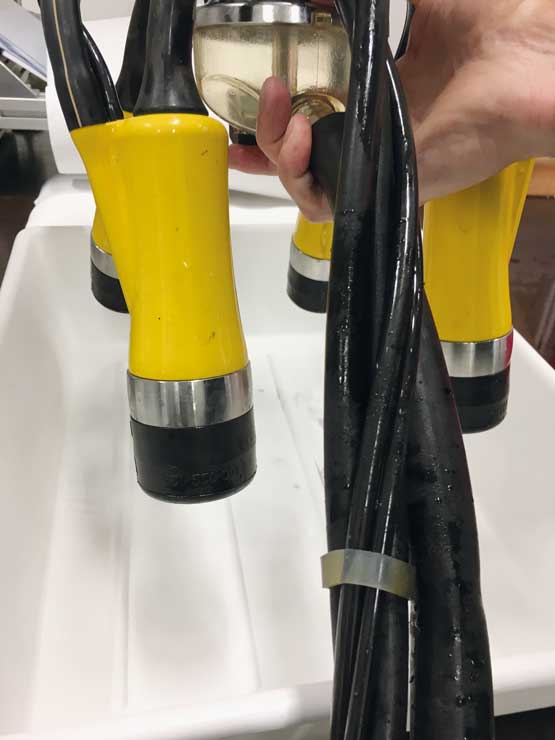
Iodine Residue
The iodine content in the milk is subject to physiologicall variations, for example depending on feeding, climatic conditions and time of day. Current literature suggests a variation range of 30-530 μg/l. Accordingly, it is difficult to assess this in practice, whereby the iodine content must be comparatively monitored over a given period.
To determine whether automatic dipping with the ADF system affects iodine content in milk, tests were carried out at test farm 1 with a hard transition between the automatic and manual dipping methods. The average iodine content in the milk on farm 1, with regular dipping with the ADF system, was 240 μg/l. After the change to manual dipping an average amount of 168 µg/l was recorded. a ‘null’ test variation – not dipping at all – was not tested, so as not to threaten the health of the animals on the farms.
The results of this analysis indicated a 30 % higher iodine content in the milk samples after automatic dipping, where the variation inherent in both methods reduces the significance of the increase. The question as to the cause of the increased iodine content could not be definitively answered.
It is, however, known from scientific studies that, as well as environmental factors, operational factors, such as a greater degree of teat coverage, can lead to increased iodine content in the milk.
In order to rule out a physiological cause, additional laboratory tests were carried out on an artificial cow. The UHT milk used in the first laboratory test demonstrated an iodine content of 230 μg/l. In the ‘before and after milking’ test, the iodine in the UHT milk increased by 15.7 % on average, therefore considerably less than in the practical tests. The difference was, due to the variation in analysis results in both milk batches, statistically insignificant and lay around the tolerance limit of the analyses (15 %). Given that absorption of iodine through the artificial teats can be ruled out, the increase could be explained, by taking into account iodine transmission.
In a complimentary milking test with the starch solution, no coloured liquid residue could be found in the liners and and the claw. There were only some coloured remnants of fluid on the outside of the liner heads, in small amounts. Even the milked out starch solution, as with the previous tests, did not reveal any visible colouration after milking. Photometric assessment of the starch solution was not carried out.
Where the liners fell across each other, no flushing solution got into the claw, nor did it when the cluster was inverted (in the back flushing position). The test results suggested that a slightly increased iodine content in the milk after dipping with the ADF system is to be expected. This corresponds to a statement by French et al. (2016) in a new study, that dipping with iodine, regardless of the method of application, leads to a higher iodine content in the milk.
Regardless of the cause of the increase of iodine content, especially in the practical testing, all levels measured were well below the maximum value recommended by the Scientific Committee on Food for Adults, a maximum of 600 μg/day and, based on a daily consumption of 200 g of dairy product per day, also below the maximum value recommended by the German Nutrition Society (DGE) (200 μg/day). According to the recommended daily consumption this corresponds to a tolerable iodine content of 1,000 μg/l.
Peracetic Acid Residue
Random control samples from the fat separators on the test farms immediately after milking showed no visible percipitation of milk proteins. In both parlours of the second farm, due to the enclosed construction and resulting lesser intensity of air flow, there was a stinging odour during the entire milking. This suggests that, during the spraying of the flush solution by the ADF system, peroxide containing aerosols are produced. However, peracetic acid is highly volatile and the ‘iFlush+’ product is used only in a comparatively low concentration of 300 ppm. Otherwise, peracetic acid can, in higher concentration, lead to the irritation of eyes and mucous membranes. A maximum workplace concentration amount for peracetic acid in the breathing air has not yet been established but is, however, being discussed at present. It is, therefore, to be advised that, where the ADF system is used, good ventilation of the parlour and related buildings is to be provided.
Table 2: Iodine content of the milk in practical and laboratory testing
| Practical Testing Farm 1 | Laboratory Testing | |||
| manual Dipping | ADF Dipping | before ADF Dipping | after ADF dipping | |
| Average iodine content | 168 | 240 | 232 | 269 |
| Increase by … | 30 % | 15.7 % |
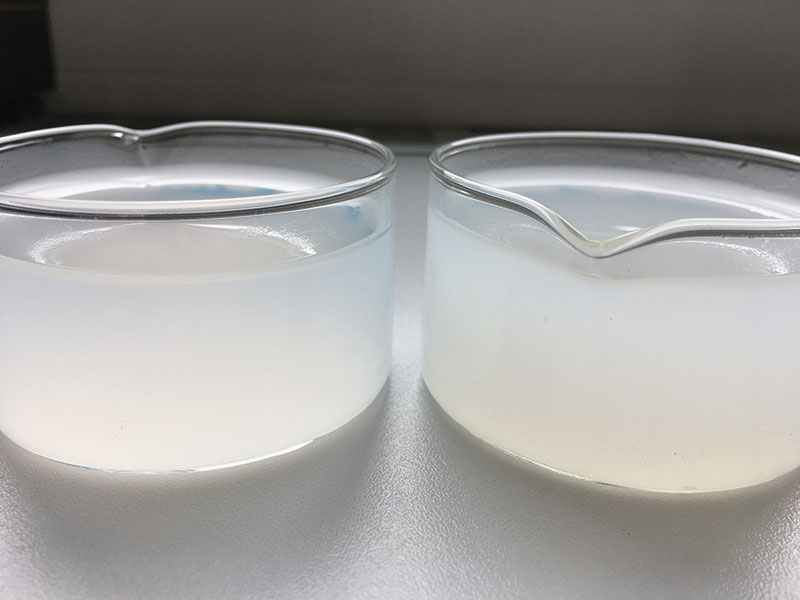
Operation and Servicing
Those farms that took part in the survey have on average 36 points with an ADF system and milk 700 cows. The ADF system came into use on most farms in the years 2015 and 2016, though earlier on 5 of the farms. The pilot farm started using ADF in mid-2013. Two thirds of the farms have put the ADF system into a rotary and a third into parlours of different types.
The most important reasons for the installation of the ADF system were, according to the farm owners, the saving of labour and reduction of workload though a reliable dipping process, due to the automation, but also the automatic disinfection in-between milkings, with respect to animal health. 90 % of respondents would buy the ADF system again if they needed to.
Operation
Staff found the system easy to work with. Beside liner changes, they named as a necessary task
the timely changing of chemical containers. This must be monitored by the operators – ADF recommends at least a daily check of the levels in chemical containers.
The ADF cluster was considered as ‚good‘ by the operators. A few respondents noted that it could be a little lighter and that the tubing could be better arranged. The liner changes were regarded as
comparably time-consuming and, as such, got a ‘medium’ rating. As the injectors are integrated into the liners, these must be correctly inserted at each change. This requires more time and routine. Equally, the 2,000 milkings interval between liner changes, recommended by ADF for the trouble free operation of the ADF system, was viewed by some operators as somewhat short.
Especially highlighted were the very good dipping results and the overall good functionality of the ADF system.
At the automatic removal and hanging up of the clusters, according to respondents, on average, 30 % had flipped over liners. On reflection, this was no more frequent that with clusters previously used. In three farms, the occurrence of flipped over liners was especially pronounced.
The aerosol load into the air through the peracetic acid was mainly not considered critical, most likely barely noticeable. On two farms, depending on structural situation, the odour was felt to be ‘evidently’ to ‘pronouncedly’ detectable.
Servicing
The servicing of the ADF system occurs at regular intervals, every 6,000 milkings or at least twice yearly according to the terms of the service agreement and is carried out by an ADF technician. Apart from the liner change, which ADF recommends to be carried out every 2,000 milkings and the regular changeover of chemical containers, there are no further time-consuming tasks incumbent upon the operators.
The requirement to change liners is indicated by the system via a yellow warning light in the parlour.
This illuminates as standard when 35 % of the milking points have reached 2,000 milkings. This threshold can be adjusted to suit the individual operational conditions.
Functional checks as described above are also recommended. To this end, ADF Milking makes available a service checklist. As part of the regular servicing, water and chemical levels are checked, among other things, including concentrations, which are checked and adjusted.
System failures affecting the dipping and flushing functions happen ‘rarely’ to ‘not at all’, according to the operators. Small issues such as defective valves at milking points or compensation tanks only occurred sporadically. In some cases the suction pump or the distribution of chemical at the control unit failed. The respondents were ‘satisfied’ to ‘very satisfied’ with the speed and reliability of the ADF service.
Summary
In the preceding DLG-recognised partial examination, the ADF5 automatic dipping and flushing system
was tested with respect to its main functions – ‘dipping’ and ‘flushing/disinfecting’. The quality of both
functions was visually checked on two practice farms and the effectiveness of the disinfection was tested
with swab samples.
Furthermore, the chemical usage was measured on the test farms. With respect to the subject of iodine residue, practical and laboratory tests were carried out, to determine effects and their causes. The ADF5 system scored well, due to the very reliable and complete coverage of the teat with dip
as well as the good functioning of the liner disinfection. When the system was tested for chemical residue, a slightly higher iodine content in the milk was found. A technical cause could not statistically be confirmed, but there were suggestions of physiological effects, such as increased absorption of iodine by the skin,
which is also to be expected with manual dipping.
The operators of the ADF system are satisfied with the function, operability and manufacturer’s service
and gave an overall ‘good’ rating for these. The dip results gained a ‘very good’ rating and were especially
by the DLG testing.
The product fulfils the requirements of the DLG test parameters for automatic milking systems in the relevant criteria as well as the requirements set forth by the DLG testing commission for milking technology.
Applicant and test performer
Applicant
ADF Milking Deutschland GmbH,
Georg-Glock-Straße 4,
40474 Düsseldorf
Manufacturer
ADF Milking Ltd,
1 Camelia Court,
Shellbridge Road,
Slindon, West Sussex,
BN18 0LT
Contact:
Phone: +49 (0)4087 408018,
Fax: +49 (0)211 2989198,
info.de@adfmilking.com
www.adfmilking.com
Test performed by
DLG e.V.,
Testzentrum Technik und Betriebsmittel,
Max-Eyth-Weg 1,
64823 Groß-Umstadt
DLG-Prüfrahmen
Automatische Melksysteme (Stand 04/2013)
Fachbereich
Tierhaltung, Innenwirtschaft
Laborleiter
Dipl.-Ing. Stefano Mastrogiovanni
Prüfingenieur(e)
Dipl.-Ing. agr. Susanne Gäckler *
Vertreter der DLG-Prüfungskommission:
Dr. Jan Harms (Bayerische Landesanstalt für Landwirtschaft), Wolfgang Spörer (LKV Sachsen-Anhalt), Dr. Wilfried Wolter (Regierungspräsidium Gießen, Fachtierarzt für Milchhygiene) †, als Gast: Dr. Friederike Reinecke (Regierungspräsidium Gießen)
* Berichterstatter
Contact
DLG TestService GmbH - Groß-Umstadt location • Max-Eyth-Weg 1 64823 Groß-Umstadt Germany • Tel.: +49(0)69 24 788-611 • tech@DLG.org

